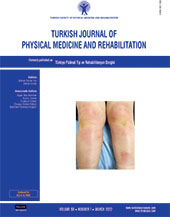Frequency of carpal tunnel syndrome and hand dysfunction in prediabetes: A cross-sectional, controlled study
2 Department of Physical Medicine and Rehabilitation, Kayseri City Hospital, Kayseri, Turkey
3 Department of Neurology, Kayseri City Hospital, Kayseri, Turkey DOI : 10.5606/tftrd.2022.6828 Objectives: This study aims to evaluate the frequency of carpal tunnel syndrome (CTS), to investigate the impairment of hand functions in patients with prediabetes (PD), and to compare laboratory findings of PD patients with and without CTS.
Patients and methods: Between June 2018 and January 2019, a total of 115 patients (29 males, 86 females; mean age: 51.4±11.8 years; range, 24 to 78 years) who were recently diagnosed with PD and a total of 54 healthy participants (17 males, 37 females; mean age: 48.4±13.2 years; range, 21 to 78 years) as the control group were included. Demographic and clinical data of the patients including oral glucose tolerance test (OGTT) and glycated hemoglobin (HbA1c) were recorded, and both groups were examined for the presence of CTS. Clinically suspected CTS was confirmed by electrodiagnostic studies. The hand grip strength (HGS) was measured and hand functions were evaluated using the Duruöz Hand Index (DHI).
Results: There were no significant differences in the age, sex, occupation, body mass index (BMI), or insulin resistance between the groups. A total of 24 (20.9%) patients with PD and eight (14.8%) healthy controls had CTS (p=0.349). Hand functions were worse in the PD patients than the control group (p=0.044). Age, occupation, BMI, insulin resistance, OGTT at 0 and 2 h, and HbA1c values were similar between the PD patients with or without CTS.
Conclusion: Our study, for the first time, reveals that CTS is slightly more common and hand functions are impaired in PD compared to the healthy individuals. Based on these findings, we suggest that hand functions should be evaluated in PD patients.
Keywords : Carpal tunnel syndrome, hand function, prediabetes
















